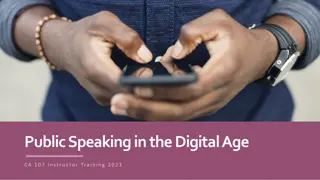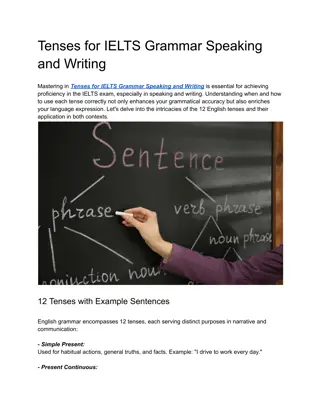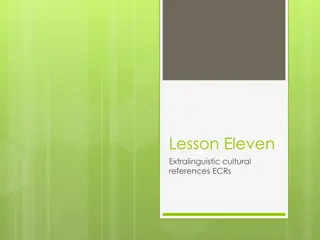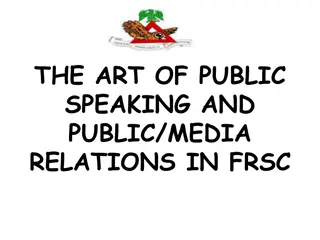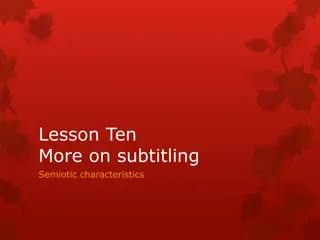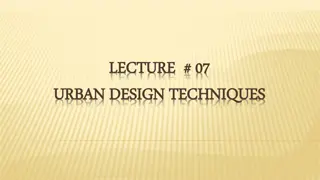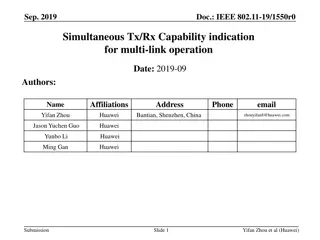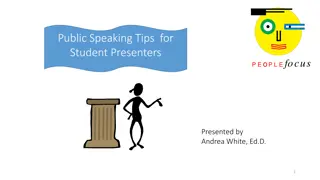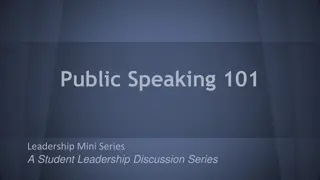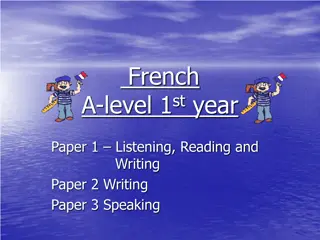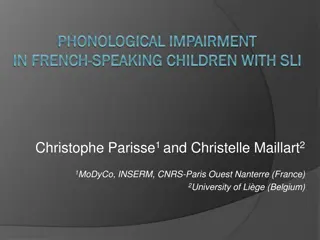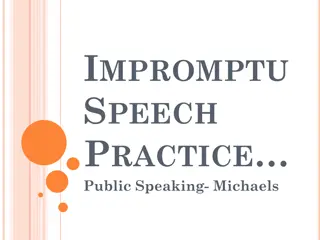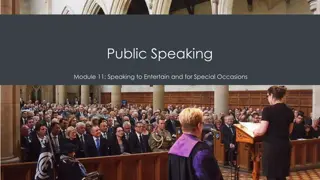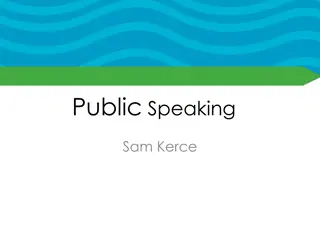Re-speaking: Simultaneous Subtitling Technique
Re-speaking is a technique that involves simultaneous subtitling of television programs using speech recognition software to translate oral text into written text live. It combines human expertise with machine capabilities, allowing for efficient and accurate transcription. This innovative process enables real-time conversion of spoken content into text, catering to various sectors beyond TV subtitles, such as medical chart reporting and accessibility for the deaf community in educational and professional settings.
Download Presentation

Please find below an Image/Link to download the presentation.
The content on the website is provided AS IS for your information and personal use only. It may not be sold, licensed, or shared on other websites without obtaining consent from the author.If you encounter any issues during the download, it is possible that the publisher has removed the file from their server.
You are allowed to download the files provided on this website for personal or commercial use, subject to the condition that they are used lawfully. All files are the property of their respective owners.
The content on the website is provided AS IS for your information and personal use only. It may not be sold, licensed, or shared on other websites without obtaining consent from the author.
E N D
Presentation Transcript
RE-SPEAKING Simultaneous subtitling
What is re-speaking? The techniques used to subtitle television programmes live. An innovative process and product. Collaboration of man and machine. Eugeni (2006) rispeakeraggio e rispeaker
Definition Simultaeous subtitling using speech recognition software. Through respeaking, an oral text is translated simultaneously into a written text.
Man and Machine Respeaker Speech recognition software
Voice recognition - Speech recognition Voice recognition recognise single commands eg. SIRI Speech recognition recognise more complex texts eg for letter writing or, with subtitles, for audiovisual translation.
Speaker independent system Speech recognition of any voice.
Speaker dependent system For a specific speaker for whom a personalised voice profile must be formed. The software must be trained to recognise a particular voice. (voice timbre, speech speed, articulation) This sytem reduces the margin of error.
How does it work? A set of algorhythms keep track of errors and corrections, enabling the programme to improve by taking note of the preceding corrections.
Interdependence Ribas e Romero Fresco (2008) point out that, if the software is dependent on the respeaker (speaker dependent), the respeaker is also software dependent . Both have to work well.
1 2 3 4 Oratore iniziale TP Software TI(2) Sottotitoli TA Respeaker TI(1) Fig. 10.1 Il processo di respeaking
Uses Apart from for subtitles for TV (eg. weather forecast), respeaking is used in medicine (reporting clinical charts) and for the deaf in contexts such as university lectures, congresses, etc.
Lambourne (2007): Real-time transcription using speaker-dependent speech recognition of the voice of a trained narrating interpreter in order to provide near simultaneous subtitles with the minimum of errors . He speaks of the product rather than the process (his company makes the subtitles)
Eugeni Una riformulazione, una traduzione o una trascrizione di un testo [...] prodotta dal rispeaker ed elaborata dal computer in contemporanea con la produzione del testo di partenza [...]. Il software di riconoscimento del parlato procede alla trasformazione dell input orale in testo scritto . He is a respeaker.
Eugeni cont. The respeaker riformulates, translates or transcribes a text in a context of simultaneity, dividing his/her attention between listening and understanding the source text and reproducing orally the intermediate text.
And the intermediate text, more or less correct, is then processed by the computer, more or less correctly, thereby producing a more or less accurate target text.
LESSON NINE PART TWO Voice-over
AVT methods Interlingual subtitling Intralingual subtitling Dubbing Voice-over Real time subtitling Interpreting Narration Comment Multilingual production Surtitling Audiodescription (audio-subtitling)
Voice-over (intralingual) For example Richard Basehart, in the 1956 film version of Moby Dick, narrates the story as Ishmael. Kubrick s Barry Lyndon is similarly narrated from off screen. Voice-over technique is also used to give voices and personalities to animated characters. Robin Williams in the original, and Gigi Proietti in the Italian version, voiced over the Genie in the Walt Disney film of Aladdin.
Grigaraviit and Gottlieb (2005: 91) the monumental lack of professional and academic interest
The theory is the translation of films and television series involves the use of creative imagination and cultural sensitivity, in the long-established literary tradition, while news broadcasts and nature documentaries such as David Attenborough s series for the BBC (translated into all major languages), involve objective, factual information and are thus theoretically less challenging.
Gambier Voice-over: simultaneous interpreting approximately synchronous delivery. Applied mainly to spontaneous speech. Narration: the original speech is prepared, translated and possibly condensed in advance and then read.
Franco Voice-over narration oral statements spoken by an unseen speaker situated in space and time other than that simultaneously being presented on the screen .
Orero The target language voice that we can hear has to start reading the translation some two seconds after the original speech has started . the translation tends to finish a couple of seconds before the end of the original dialogue so that the orignal soundtrack can be heard.
Mailhac This type of translation is not properly recognised by professional translators, by translation companies, by professional organisations, by translator training institutions or by translation studies.
UAB course (Matamala) to make sure that students are familiar with the specific features of this AV transfer mode, that they are able to produce translations adapted to the requirements of the industry, and that they are also able to perform under different working conditions .
Voice-over for documentaries Difficulties inadequate information provided; length of text; orality (foreign speakers); culture-bound terms; plays on words; commissioner s intervention eg. political, business.
Register It is important to know something of the potential audience as it may be that a programme is aimed at the general public, therefore requiring a middle register satisfying the majority of listener-viewers, or at experts in the field where such an approach may be seen as condescending.
Attenborough The afore-mentioned David Attenborough nature documentaries (Planet Earth, The Blue Planet, etc.) use an educated but not specialist register which is sufficiently scientific to give the programmes prestige and credence and sufficiently accessible to gain a massive world-wide audience. This style and register is what translators and speakers must try to emulate.
Condensation The need to condense, especially if the original speaker has a rapid delivery, and because of the need to start later and finish earlier than the original, is a constant constraint and requires expertise.
Foreignisation/Localisation The question of foreignisation or localization must be dealt with, often on the fly, especially where names of people, places, etc. are involved. Documentary coverage of events such as the Burmese elections will be full of often unpronounceable names of towns, tribes and so on, and the translator must be careful not to confuse the target audience.
Idiomatic language, etc. The same applies to plays on words, proverbial expressions, colloquialisms and idiomatic language in general. Even President Obama s speech to the American nation, though less culturally diverse for, say, an Italian audience, will be full of rhetoric dictated by the protocols of American government practice and this must be conveyed.
Censorship All of these difficulties are compounded if the television company or other commissioner of the translation lays down ground rules that basically censor certain elements or dictate a certain attitude towards events. Eg. Fox News
Errors There may even by errors in the original which the translator, ignoring the pressures for equivalent effect, may wish to correct. For example, if an original text identifies Birmingham as the state capital of Alabama, and this is a real example dealt with by a colleague, the translator can be seen to be doing a favour to the original writer by substituting the actual capital which is Montgomery.
Voice-over for interviews Difficulties speed of delivery differs from person to person; accent and linguistic competence; body language; idiosyncrasies; subject matter; length (2 seconds at beginning and end)
Revoicing The kind of interviews that are revoiced are typically those that appear on news broadcasts or current affairs programmes, even light entertainment shows and sports broadcasts. The interviewees are not usually pre-prepared and therefore they display all the hallmarks of genuine spontaneous conversation. The translator has therefore to weave a path through false starts, incomplete sentences, hesitations, pauses, incoherent stretches of discourse and so on.
Synchrony The interviewees are usually shown in close-up and thus, unlike documentary comment, require a certain amount of synchrony to be believable.
Smoothing over However, generally speaking, translators tend to smooth over all the fault-lines thereby giving the impression that the interviewee is totally coherent and sticks constantly to the subject, answering the questions he is posed in the most efficacious manner. Some rock musicians, for example, who are, or feign to be, inarticulate in interviews come over as erudite orators.
or not? There is an argument to suggest that the revoicer could attempt to re-evoke the incoherences present in the original interview, thereby reinforcing the interpersonal element in the discourse (see Kovacic on the interpersonal element in subtitling), though the risk of seeming incompetent probably discourages revoicers from entering too far into this terrain.
Idiolect The quirks and oddities associated with the idiolect of any particular individual can be challenging. Strong regional accents can also prove an obstacle. Kenny Dalglish, the former Liverpool footballer, was notoriously difficult to understand with his thick Glasgow accent.
Specialisation In all specialized sectors, from nuclear physics to football, a translator not familiar with the technical terminology or the history, traditions, etc. of the field, will experience obvious difficulty. The time and opportunity to read up on the subject in question are rarely found.
The commercial video Promotional material for the vast array of products and services on the world market make up an enormous potential corpus of original and translated videos. Eg. the translating and revoicing of product promotions on video (e.g., cruise ships built by Fincantieri in Monfalcone) and tourist material (e.g., video promotions for the Friuli-Venezia-Giulia region).
A commercial enterprise The target public must receive an attractive and understandable product, hence potentially confusing or controversial elements need to be tempered if promotional material is to be successful. the focus on localization strategies.
VOICE-OVER Registration Broadcast Monitored and checked against a script Approval Time-coded copy Final mix Spotting Mixing and editing Translation Choose a speaker Recording
Pre-recorded voice-over the first phase in the process is that of the registration of the necessary information. The video must then be monitored and, if possible, checked against a script. A time-coded copy of the video is then produced and the entries spotted , to use a term familiar from subtitling.
Then The text is then translated and a revoicer chosen. The voice-over director supervises the recording of the translated text which then has to be mixed and edited to fit in with the visuals and the other sounds in the video, for example music. The finished product must then be approved and broadcast, and hopefully appreciated by the audience.
Voice-over for films Voice-over is used for foreign film translation in many countries in eastern Europe eg. Poland, Estonia, Latvia.
Vitkus (1995: 316) like subtitling in Scandinavia and dubbing in Italy, the long tradition and peoples expectations also play an important role in the continuation of this practice. in Latvia, there is a long standing tradition that cannot and will not be changed (my italics).
Lambert and Delabatista (Imberti) Repetitio: the sign is repeated with no change in form; Adjectio: with additions or modifications; Detractio: incomplete; Transmutatio: repetition in a different order; Substitutio: substitution by another sign In a film employing voice-over, the images remain the same (repetitio), the original soundtrack is curtailed to some extent (detractio) and the voice-over itself is an example of adjectio.
Level of constraint Music Image Spatial synchrony Temporal sunchrony Phonetic synchrony Spoken language Level of constraint Text ------- ------- ------- ------- ------- ------- 0 Static image Series of images ------- x Ads ------- x ------- ------- ------- 1-2 Comic ------- x ------- ------- ------- 2 Song x x ------- x 4 Subtitlesx Dynamic images x x ------- ------- 3-4 Dubbingx Dynamic images ------- x x x 4-5
Level of constraint for voice-over Music Image Spatial synchrony Temporal synchrony Phonetic synchrony Spoken language Level of constraint Dynamic images Voice- over x ------- x ------- x 3-4
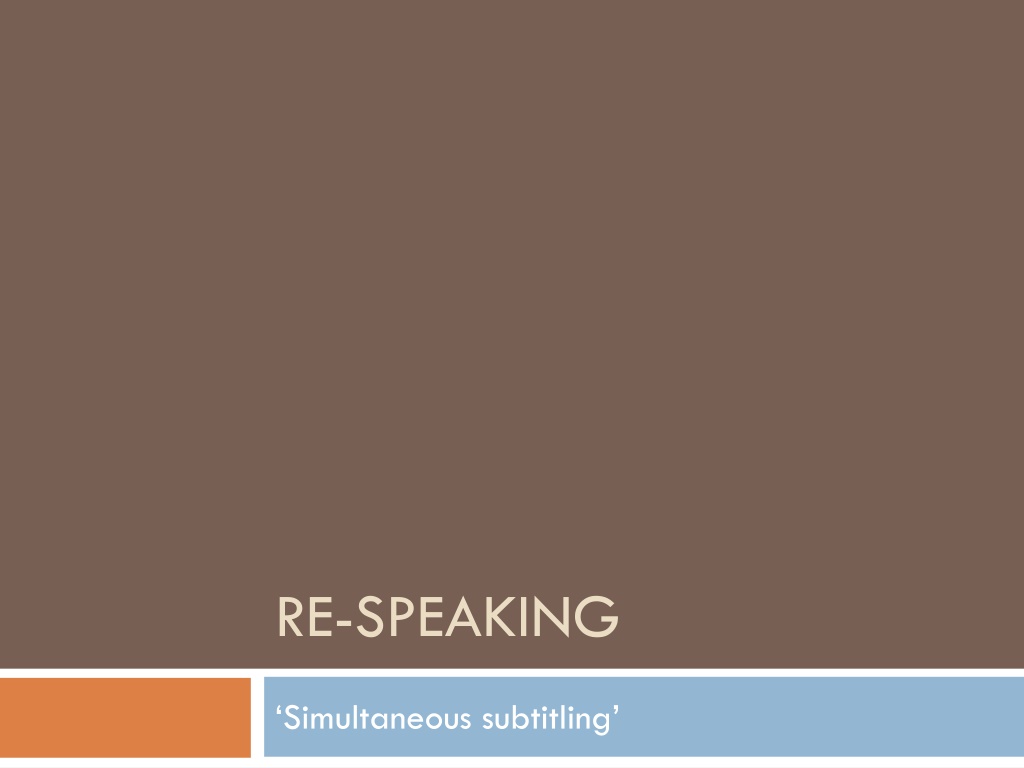
 undefined
undefined



